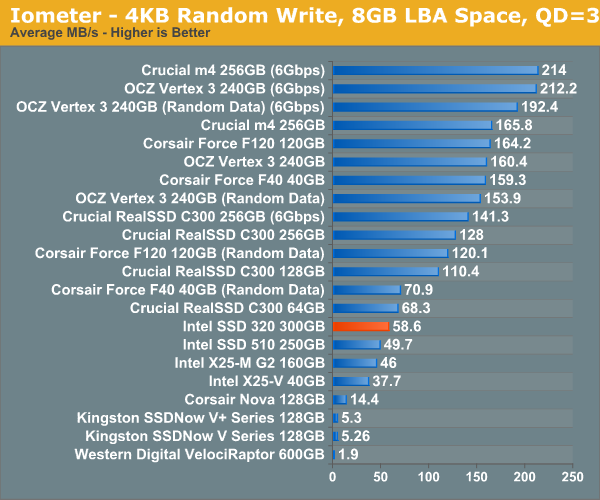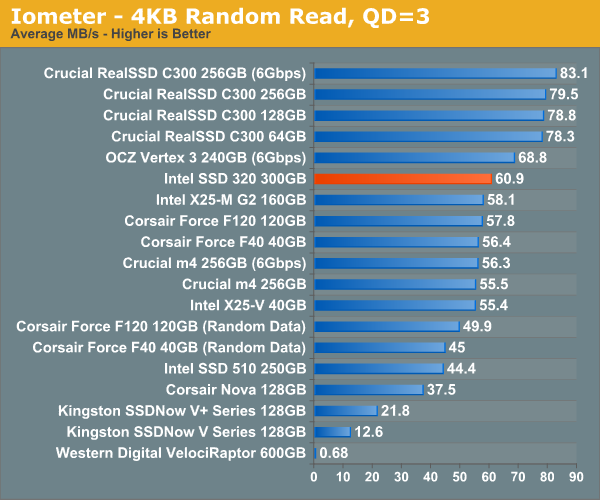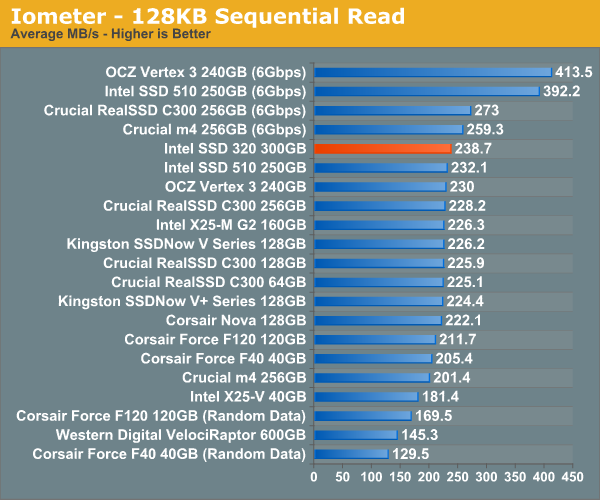The Intel SSD 320 Review: 25nm G3 is Finally Here
by Anand Lal Shimpi on March 28, 2011 11:08 AM EST- Posted in
- IT Computing
- Storage
- SSDs
- Intel
- Intel SSD 320
Random Read/Write Speed
The four corners of SSD performance are as follows: random read, random write, sequential read and sequential write speed. Random accesses are generally small in size, while sequential accesses tend to be larger and thus we have the four Iometer tests we use in all of our reviews.
Our first test writes 4KB in a completely random pattern over an 8GB space of the drive to simulate the sort of random access that you'd see on an OS drive (even this is more stressful than a normal desktop user would see). I perform three concurrent IOs and run the test for 3 minutes. The results reported are in average MB/s over the entire time. We use both standard pseudo randomly generated data for each write as well as fully random data to show you both the maximum and minimum performance offered by SandForce based drives in these tests. The average performance of SF drives will likely be somewhere in between the two values for each drive you see in the graphs. For an understanding of why this matters, read our original SandForce article.

Random write speed is improved compared to the 510 thanks to Intel's controller, but we're only looking at a marginal improvement compared to the original X25-M G2.
Many of you have asked for random write performance at higher queue depths. What I have below is our 4KB random write test performed at a queue depth of 32 instead of 3. While the vast majority of desktop usage models experience queue depths of 0 - 5, higher depths are possible in heavy I/O (and multi-user) workloads:


Random read performance has always been a strong point of Intel's controller and the 320 is no different. While we're not quite up to C300 levels, the 320 is definitely competitive here.
Sequential Read/Write Speed
To measure sequential performance I ran a 1 minute long 128KB sequential test over the entire span of the drive at a queue depth of 1. The results reported are in average MB/s over the entire test length.

Without a 6Gbps interface the 320's performance is severely limited. Compared to other 3Gbps drives the 320 is quite good here though.

Read performance is at the top of the chart for 3Gbps drives. I wonder how far Intel would've been able to push things if the 320 had a 6Gbps controller.










194 Comments
View All Comments
sean.crees - Tuesday, March 29, 2011 - link
Have you thought that perhaps the new change was in your best interest? That maybe their trying to fix a problem before you notice it.Think about it, as a company, you would want to give your customers what they want. You'd give them all the space they'd want, i mean why not right? You'd want all the biggest numbers possible to slap on your box so you can brag to the entire market your the best. Then the only reason to make it less is to pre-emptively keep a potential problem from happening.
You have to remember, OCZ isn't Intel, they don't make these parts. They just put it together and repackage it. If their Nand suppliers suddenly have issues, they can't just stop selling products, they would go bankrupt, but a slight change in product specs that most people will never notice in real world usage to prevent future issues because of hardware supply problems?
I'm not saying this is what happened, but it is just one of many possible reasons why the change was made.
OCZ doesn't have intels Q&A because they can't afford it. What would you prefer, having only Intel SSD's because no one else can afford to be competative with them in this market and have the same Q&A and parts. Or some competition with some sacrifices? Most would agree this is the lesser of two evils.
But what OCZ lacks in funding they make up in customer support. You can go to their forums, make a post and within a reasonable amount of time get an actual tech from their company to respond to you with options to fix your problem. You don't get that personal touch from Intel. With Intel, if it's not in the box when you buy it, then you don't get it.
jwilliams4200 - Wednesday, March 30, 2011 - link
Lowering the performance of the product, and giving 5GB less space than advertised (or using lower tier flash memory) is NOT in the best interest of the customer. It was in OCZ's best interest to try to deceive their customers so OCZ could increase its profits, so that is what OCZ did.sean.crees - Wednesday, March 30, 2011 - link
And you have proof they intentionally used sub standard nand to increase profits? Or are you just making stuff up?jwilliams4200 - Wednesday, March 30, 2011 - link
OCZ has been using flash chips in some SSDs that have the Micron logo and then the SpecTek logo stamped on top. SpecTek sells flash chips that Micron will not sell. SpecTek is a lower tier.Making things up? Hardly. This has been discussed at length in a number of forums, and you can easily find credible pictures of the flash chips in OCZ SSDs from people who opened up the SSDs.
Ema Nymton - Tuesday, April 5, 2011 - link
Funny you say that,I just had the same discussion with a friend of mine.
Then I went with a OCZ deneva and opened it.
Guest what I found Intel Nan flash in it...
sean.crees - Tuesday, March 29, 2011 - link
Intel had the reliability vs speed in the 1st and 2nd gen SSD's, but the difference then was that the speed was competitive. It's not even close this time.Another thing i have against Intel, i was one of their early 1st gen adopters, 2x 80gb drives for $500 a pop. I'm the guy Intel screwed out of TRIM support because they didn't feel like sharing a firmware update that enables it for me. So i still have a bitter taste in my mouth over that, especially now that its been a few years and my 1st gen SSD's are starting to feel more like a fast HDD. :*(
Also, Sandforce and OCZ seem to have learned how important stability and performance sustainability are in this market. They have some of the best garbage collection without TRIM available. That's important especially for people considering OS's that don't support TRIM, or for RAID usage.
Intel may have created this market, but its competitors have learned the lessons Intel shared while Intel still needs to learn how to support its existing customer base like OCZ has gotten very good at. This is the problem with being #1 for too long, you begin to think you can do no wrong, and all your choices are the right ones that everyone else should conform to. This is fine as long as you keep your competitive edge, but once you lose that, you risk losing everything.
Intel may be able to brag about stability for now, but i have a feeling as time goes by people will realize that Sandforce drives are just as stable, and then Intel loses its only Ace left in it's hand.
jwilliams4200 - Tuesday, March 29, 2011 - link
You sound like an OCZ spin doctor.No, the Sandforce garbage collection is not one of the best. It is actually highly flawed. If you use the drive heavily, the write speed will drop, and it will stay low, even after TRIM, for up to a week. And Sandforce has done nothing to fix this. OCZ, in typical con-man fashion, claims it is a feature, but that is obviously a lie. If it were a feature, it would be documented under what circumstances it happens, how much the write speed decreases, and for how long. The write speed would drop more, too, since 30% drop in write speed is not going to do much to save the flash, even if the flash were really in danger, which it should not be. And if it were a feature, Sandforce would offer the ability to turn it off, if not by the user, at least by the vendor. No, it is a design flaw.
Even if OCZ users do not get deceived by OCZ in the future (by OCZ changing the internals to make the drive less reliable or perform worse), it is obvious that Intel will remain more reliable and stable than OCZ. There is just no comparison between the quality control and testing that happens at Intel, as an entire corporate culture, in contrast to OCZ, where the corporate culture is to take short-cuts, use the cheapest parts possible, lie to the customers whenever they feel like it, and then send the spin doctors out on the forums to attempt damage control. Ever since the OCZ spin doctors pretended to be users on hardforum years ago, it has been clear what sort of company OCZ is.
Acrono - Tuesday, March 29, 2011 - link
You sound like an Intel spin doctor.jwilliams4200 - Tuesday, March 29, 2011 - link
I have no association with Intel, other than appreciating their reliability. But of course there is no way for you to know that. The difference is that OCZ has a history of having their people post on forums, posing as non-OCZ "regular people". Intel has no such shady history.sean.crees - Tuesday, March 29, 2011 - link
I've actually never owned an OCZ product ever. But i keep up with how different companies in the IT domain behave. I read reviews, and keep up with trends."If you use the drive heavily", which the average consumer won't ever do. If you are going to be using this drive heavily then your making the mistake of buying a consumer product instead of a server product. You get what you pay for. Don't blame the company because your trying to use a product for a purpose it was never intended to be used for.
It is not the culture of Intel that gives them better quality control, its capital. Intel has a lot more resources available than OCZ. It can afford these premium parts, and better quality control.
Intel has good reliabilty, and if reliability is your #1 concern over all else, then your right, there is no other option. But most are willing to gamble that they will likely never see that increased reliability with intel, but will notice an increased speed with sandforce.